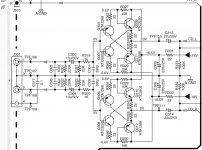Can someone please give me an explenation about how a diamond buffer works? Or a link to a good guide? I see it a lot in higher grade amplifiers but I don't get the point how they exactly works.
I see at the input two complementory transistors configurated as emitter follower connected to two other complementory transistors also configurated as emitter follower which outputs are feeded back to the collector of the input transistors ?

I see at the input two complementory transistors configurated as emitter follower connected to two other complementory transistors also configurated as emitter follower which outputs are feeded back to the collector of the input transistors ?

Hint: Not starting with a somewhat tricked-out topology helps.
Look at this article. The first circuit shown is the basic diamond buffer. As you can see, it really is nothing more than the complementary version of two complementary emitter follower stages (level shifters). There is no feedback beyond what's provided by the emitter followers themselves. You get the same basic tweaking options, like replacing the first-stage emitter resistors with current sources.
When compared to a standard complementary EF2 buffer, performance may be a bit better due to partial cancellation of nonlinearities (or worse when it comes to higher output currents), and most of all you lose a fair bit less voltage swing, though linearity of the basic circuit near the rails is not great as first-stage current varies heavily. (Current sources will improve this but they, too, have a minimum dropout voltage.)
Now what's up with the cross-connected collectors in the circuit above? This has more to do with bootstrapping than feedback. You will note that first-stage Vce is very low and remains about constant, which is beneficial in terms of power dissipation and nonlinear input capacitance. You'll need transistors that are well-behaved at low Vce though (no quasisaturation issues) - typically lowish-Vce oldies like 2N5087/2N5089 or BC550C/560C. A proper bootstrapping setup would perform better, though the extra component count of this one (exactly zero) is hard to beat.
Look at this article. The first circuit shown is the basic diamond buffer. As you can see, it really is nothing more than the complementary version of two complementary emitter follower stages (level shifters). There is no feedback beyond what's provided by the emitter followers themselves. You get the same basic tweaking options, like replacing the first-stage emitter resistors with current sources.
When compared to a standard complementary EF2 buffer, performance may be a bit better due to partial cancellation of nonlinearities (or worse when it comes to higher output currents), and most of all you lose a fair bit less voltage swing, though linearity of the basic circuit near the rails is not great as first-stage current varies heavily. (Current sources will improve this but they, too, have a minimum dropout voltage.)
Now what's up with the cross-connected collectors in the circuit above? This has more to do with bootstrapping than feedback. You will note that first-stage Vce is very low and remains about constant, which is beneficial in terms of power dissipation and nonlinear input capacitance. You'll need transistors that are well-behaved at low Vce though (no quasisaturation issues) - typically lowish-Vce oldies like 2N5087/2N5089 or BC550C/560C. A proper bootstrapping setup would perform better, though the extra component count of this one (exactly zero) is hard to beat.
- Status
- This old topic is closed. If you want to reopen this topic, contact a moderator using the "Report Post" button.